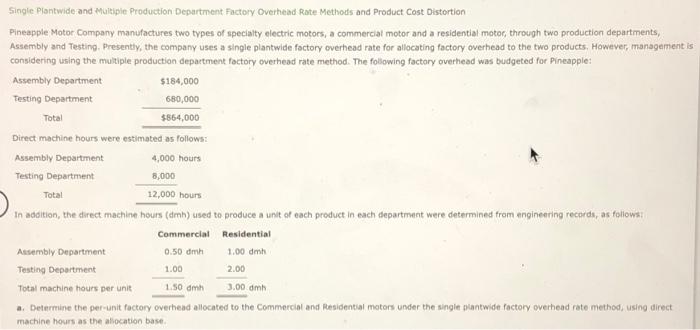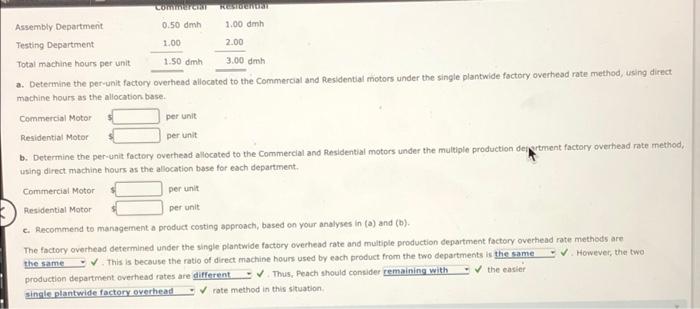Single Plantwide and Multiple Production Department Factory Overhead Rate Methods and Product Cost Distortion Pineapple Motor Company manufactures two types of specialty electric motors, a commercial motor and a residential motor, through two production departments, Assembly and Testing Presently, the company uses a single plantwide factory overhead rate for allocating factory overhead to the two products. However, management is considering using the multiple production department factory overhead rate method. The following factory overhead was budgeted for Pineapple: Assembly Department $184,000 Testing Department 680,000 Total $564,000 Direct machine hours were estimated as follows: Assembly Department 4,000 hours Testing Department 8,000 Total 12,000 hours In addition, the direct machine hours (cm) used to produce a unit of each product in each cepartment were determined from engineering records, as follows: Commercial Residential Assembly Department 0.50 m 1.00 de Testing Department 1.00 Total machine hours per unit a. Determine the per unit factory overhead allocated to the Commercial and Residential motors under the single plantwide factory overhead rate methods using direct machine hours as the allocation base 2.00 1.50 m 3.00 am RESTO Commerce Assembly Department 0.50 dmh 1.00 dmh Testing Department 1.00 2.00 Total machine hours per unit 1.50 m 3.00 dm a. Determine the per unit factory overhead allocated to the Commercial and Residential motors under the single plantwide factory overhead rate method, using direct machine hours as the allocation base Commercial Motor per unit Residential Motor per unit b. Determine the per-unit factory overhead allocated to the Commercial and Residential motors under the multiple production destment factory overhead rate method, using direct machine hours as the allocation base for each department. Commercial Motor per unit Residential Motor per unit Recommend to management a product conting approach, based on your analyses in (a) and (b). The factory overhead determined under the single plantwide factory overhead rate and multiple production department factory overhead rate methods are the same This is because the ratio of direct machine hours used by each product from the two departments is the same V. However, the two production department overhead rates are different Thus, Peach should consider remaining with the easier single plantwide factory overhead rate method in this situation








